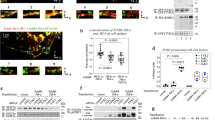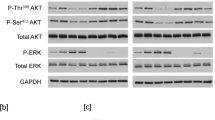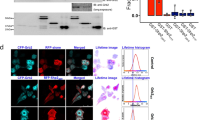Abstract
The ErbB-4 receptor tyrosine kinase homo- and heterodimerizes following heregulin binding, which provokes increased levels of tyrosine autophosphorylation. Unique to the ErbB family, ErbB-4 is then proteolytically cleaved by α- and γ-secretase to produce an 80 kDa intracellular domain (s80 ICD) fragment. This fragment is found in both the cytoplasm and nucleus of many normal and cancer cells and can interact with transcription factors in the cytoplasm and nucleus. Since the s80 ICD lacks ectodomain sequences known to play a major role in dimerization of ErbB family members, we asked whether the s80 ICD is an active tyrosine kinase. Here, we demonstrate that the s80 ICD is a constitutively active tyrosine kinase and can form homodimers. The s80 ICD is autophosphorylated in cells and can phosphorylate an exogenous substrate in vitro. Also, the s80 ICD can coassociate and dimers are detected by chemical crosslinking. This is the first example of constitutive kinase activation and dimerization totally within the cytoplasmic domain of an ErbB receptor and suggests that the s80 ICD may function to phosphorylate substrates in the cytoplasm or nucleus.
This is a preview of subscription content, access via your institution
Access options
Subscribe to this journal
Receive 50 print issues and online access
$259.00 per year
only $5.18 per issue
Buy this article
- Purchase on Springer Link
- Instant access to full article PDF
Prices may be subject to local taxes which are calculated during checkout




Similar content being viewed by others
References
Aifa S, Aydin J, Nordvall G, Lundström I, Svensson SPS, Hermanson O . (2005). Exp Cell Res 302: 108–114.
Arteaga CL, Ramsey TT, Shawver LK, Guyer CA . (1997). J Biol Chem 272: 23247–23254.
Bei R, Budillon A, Masuelli L, Cereda V, Vitolo D, Di Gennaro E et al. (2004). J Pathol 204: 317–325.
Biscardi JS, Maa M-C, Tice DA, Cox ME, Leu T-H, Parsons SJ . (1999). J Biol Chem 274: 8335–8343.
Burgess WA, Cho S-S, Eigenbrot C, Ferguson KM, Garrett TPJ, Leahy DJ et al. (2003). Mol Cell 12: 541–552.
Carpenter G . (2003). Exp Cell Res 284: 66–77.
Chantry A . (1995). J Biol Chem 270: 2068–3073.
Chattopadhyay A, Vecchi M, Ji Q-S, Mernaugh R, Carpenter G . (1999). J Biol Chem 274: 26091–26097.
Cheng Q-C, Tikhomirov O, Zhou W, Carpenter G . (2003). J Biol Chem 278: 38421–38427.
Gassmann M, Casagranda F, Orioli D, Simon H, Lai C, Klein R et al. (1995). Nature 378: 390–394.
Hughes DPM, Thomas DG, Giordano TJ, Baker LH, McDonagh KT . (2004). Clin Cancer Res 64: 2047–2053.
Jones FE, Welte T, Fu X-Y, Stern DF . (1999). J Cell Biol 147: 77–87.
Junttila TT, Laato M, Vahlberg T, Söderström K-O, Visakorpi T, Isola J et al. (2003). Clin Cancer Res 9: 5346–5357.
Junttila TT, Sundvall M, Lundin M, Lundin J, Tanner M, Härkönen P et al. (2005). Cancer Res 65: 1384–1393.
Landau M, Fleishman SJ, Ben-Tal N . (2004). Structure 12: 2265–2275.
Lee H-J, Jung K-M, Huang YZ, Bennett LB, Lee JS, Mei L et al. (2002). J Biol Chem 277: 6318–6323.
Long W, Wagner K-U, Lloyd KCK, Binart N, Shillingford JM, Hennighausen L et al. (2003). Development 130: 5257–5268.
Murali R, Brennan PJ, Kieber-Emmons T, Greene MI . (1996). Proc Natl Acad Sci USA 93: 6252–6257.
Ni C-Y, Murphy NP, Golde TE, Carpenter G . (2001). Science 294: 2170–2181.
Penuel E, Akita RW, Sliwkowski MX . (2002). J Biol Chem 277: 28468–28473.
Rio C, Buxbaum JD, Peschon JJ, Corfas G . (2000). J Biol Chem 275: 10379–10387.
Sartor CI, Zhou H, Kozlowska E, Guttridge K, Kawata E, Caskey L et al. (2001). Mol Cell Biol 21: 4265–4275.
Srinivasan R, Gillett CE, Barnes DM, Gullick WJ . (2000). Cancer Res 60: 1483–1487.
Stamos J, Sliwkowski MX, Eigenbrot C . (2002). J Biol Chem 277: 46265–46272.
Tidcombe H, Jackson-Fisher A, Mathers K, Stern DF, Gassmann M, Golding JP . (2003). Proc Natl Acad Sci USA 100: 8281–8286.
Vaskovsky A, Lupowitz Z, Erlich S, Pinkas-Kramarski R . (2000). J Neurochem 74: 979–987.
Vecchi M, Baulida J, Carpenter G . (1996). J Biol Chem 271: 18989–18995.
Vecchi M, Carpenter G . (1995). J Cell Biol 139: 995–1003.
Vidal GA, Naresh A, Marrero L, Jones FE . (2005). J Biol Chem 289: 19777–19783.
Williams CC, Alison JG, Vidal GA, Burow ME, Beckman BS, Marrero L et al. (2004). J Cell Biol 167: 469–478.
Yarden Y, Sliwkowski MS . (2001). Nat Rev Mol Cell Biol 2: 127–136.
Zhou W, Carpenter G . (2000). J Biol Chem 275: 34737–34743.
Zhu H-J, Iaria J, Orchard S, Walker F, Burgess AW . (2003). Growth Factors 21: 15–30.
Acknowledgements
The authors appreciate the efforts of Sue Carpenter in manuscript preparation. We also acknowledge the support of the Department of Defense Grant BC043057 to BL, NIH Grant CA97456 to GC, and both the Vanderbilt Ingram Cancer P30 CA6845 and the Vanderbilt Diabetes Center P30 DK20593 for core resources.
Author information
Authors and Affiliations
Corresponding author
Rights and permissions
About this article
Cite this article
Linggi, B., Cheng, Q., Rao, A. et al. The ErbB-4 s80 intracellular domain is a constitutively active tyrosine kinase. Oncogene 25, 160–163 (2006). https://doi.org/10.1038/sj.onc.1209003
Received:
Revised:
Accepted:
Published:
Issue Date:
DOI: https://doi.org/10.1038/sj.onc.1209003
Keywords
This article is cited by
-
Canonical ErbB-2 isoform and ErbB-2 variant c located in the nucleus drive triple negative breast cancer growth
Oncogene (2020)
-
Advanced development of ErbB family-targeted therapies in osteosarcoma treatment
Investigational New Drugs (2019)
-
Neuregulin 1 improves complex 2-mediated mitochondrial respiration in skeletal muscle of healthy and diabetic mice
Scientific Reports (2017)
-
Overexpression of ERBB4 JM-a CYT-1 and CYT-2 isoforms in transgenic mice reveals isoform-specific roles in mammary gland development and carcinogenesis
Breast Cancer Research (2014)
-
ErbB4 promotes cyclooxygenase-2 expression and cell survival in colon epithelial cells
Laboratory Investigation (2010)



